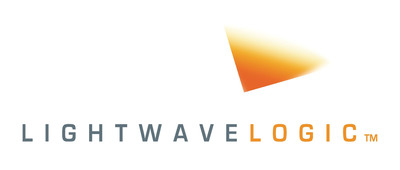Lightwave Logic's Advanced Organic Electro-Optic Polymers Surpass 2,000 Hours Of Thermal Aging At 110 Degrees Celsius With Little To No Degradation Of Material Properties
Additionally, the Company's Proprietary Organic Electro-Optic Polymers Already Exceed 500 Hours Of Photochemical Testing With No Effect On Chemical Structures
LONGMONT, Colo., Aug. 5, 2015 /PRNewswire/ -- Lightwave Logic, Inc. (OTCQB: LWLG), a technology company focused on the development of Next Generation Photonic Devices and Non-Linear Optical Polymer Materials Systems for applications in high speed fiber-optic data communications and optical computing, announced today testing of its advanced organic electro-optic polymer materials have exceeded 2,000 hours of thermal aging at 110 degrees Celsius without degradation of electro-optic activity (R33).

These thermal aging results exceed any known organic polymer and are an important part of Lightwave Logic's commercialization effort as the Company begins to implement these material systems into advanced photonic devices for the telecom and datacom markets.
Separately, Lightwave Logic has announced that in an attempt to induce changes in the photochemical structure of the Company's materials, it is well into its photochemical stability testing of its material candidates by exposing them to the visible light spectrum. The current testing has exceeded 500 hours of operation with no discernible change in the chemical structures in an oxygen free environment. This stability testing will continue until reaching 2000 hours, an accepted industry standard.
Tom Zelibor, Lightwave Logic's Chairman and Chief Executive Officer stated, "We are now convinced that the thermal aging study results demonstrate that our organic polymer material systems are stable and can operate at higher temperatures than what currently exist in commercial datacom/telecom applications. This implies that we should see even higher stability at lower operating and storage temperatures normally seen in telecom devices that can approach up to 80 degrees Celsius.
"Even more promising is that our initial photochemical stability tests on our organic polymer material systems are proceeding exceedingly well. We have subjected our materials to light in the visible spectrum in a nitrogen environment with no noticeable degradation in their molecular structure.
"Due to an inherently broader range of wavelengths, the visible light spectrum is even more challenging than laser (concurrent) light. This helps us understand more clearly the processing and manufacturing requirements of our future commercial products and gives us the initial assurances to expect the same results as we move these materials into an actual photonic device structures. We are happy to report that initial device testing has already begun using our silicon photonic chips."
For more information about Lightwave Logic, please visit the Company's website at following URL: www.lightwavelogic.com
Powered by Lightwave Logic
Lightwave Logic, Inc. is a development stage company that produces prototype electro-optic demonstration devices and is moving toward commercialization of its high-activity, high-stability organic polymers for applications in electro-optical device markets. Electro-optical devices convert data from electric signals into optical signals for use in high-speed fiber-optic telecommunications systems and optical computers. For more information, about the Company please visit the corporate website at: www.lightwavelogic.com.
Safe Harbor Statement
The information posted in this release may contain forward-looking statements within the meaning of the Private Securities Litigation Reform Act of 1995. You can identify these statements by use of the words "may," "will," "should," "plans," "explores," "expects," "anticipates," "continue," "estimate," "project," "intend," and similar expressions. Forward-looking statements involve risks and uncertainties that could cause actual results to differ materially from those projected or anticipated. These risks and uncertainties include, but are not limited to, lack of available funding; general economic and business conditions; competition from third parties; intellectual property rights of third parties; regulatory constraints; changes in technology and methods of marketing; delays in completing various engineering and manufacturing programs; changes in customer order patterns; changes in product mix; success in technological advances and delivering technological innovations; shortages in components; production delays due to performance quality issues with outsourced components; those events and factors described by us in Item 1.A "Risk Factors" in our most recent Form 10-K; other risks to which our Company is subject; other factors beyond the Company's control.
For Further Information Contact:
Steven Cordovano
Lightwave Logic
203-952-6373
steve@lightwavelogic.com
Logo - photos.prnewswire.com
To view the original version on PR Newswire, visit:http://www.prnewswire.com/news-releases/lightwave-logics-advanced-organic-electro-optic-polymers-surpass-2000-hours-of-thermal-aging-at-110-degrees-celsius-with-little-to-no-degradation-of-material-properties-300124040.html
SOURCE Lightwave Logic, Inc.

Copyright © 2015 PR Newswire. All Rights Reserved |






